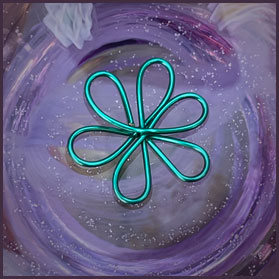I was stunned to discover all the symbolism and history of the 6-petal flower design!
In 2006 when I came across a flower bracelet design in a jewellery making book I was just drawn to its shape, little realising then of the journey it would take me on creating my own version of it or the voyage of discovery that would unfold as I learn more about its ancient history and meaning.
If you are interested in reading about how I created my unique elfin alchemy wirework flower jewellery design, and the unique journey I went on, you can read all about it in my last blog post.
In this blog post, I’m sharing with you how my flower earring design links to witchcraft in medieval times.
My life is full of coincidences… how did I first come across this? I’m not quite sure, but I think I just stumbled across a picture of the 6-petal flower symbol online and saw that it was the same as my flower jewellery design, varying slightly as it is inside a circle.
The 6-petal flower is better known as a rosette, hexafoil, or daisy-wheel symbol and has been discovered in medieval and renaissance buildings; homes, churches, and agricultural barns.
Why?
It was believed the flower rosette symbol was magical and would help protect the dwelling and its inhabitants from witchcraft and evil. The use of this symbol mostly dates to a time in our past – medieval times, from after the reformation in 1517 – when there was widespread belief in witchcraft, superstition, and the supernatural.
The 6-petal flower rosette, a magical symbol of protection was commonly used across Britain and Europe until the end of the 19th Century, and in some rural areas – in places such as Poland – was in use up until the 1950s.
Other names for it are witch mark, ritual protection mark, or apotropaic mark. ‘Apotropaic’ comes from the Greek word for averting evil and the marks were often etched into stone, plaster, or woodwork near a building’s entrance point, especially doorways, windows, and fireplaces to ward off evil from entering and protect the inhabitants from witches and evil spirits.
The most common apotropaic mark is the six-petal flower design drawn with a compass. Sometimes the circles and lines extend outside the circular flower design, with the belief that using endless lines, would confuse and entrap the evil spirits.

In medieval times, it was believed that evil spirits were at work all around us, and many different signs, symbols, and charms were used for protection and good luck, such as putting shoes in the chimney or a horseshoe above the entrance door.
Apotropaic marks are a popular topic around Halloween with many articles about them and from what I’ve read, the 6-petal flower also seems to have been used as a decorative folk-art motif representing good luck (besides its protection from witchcraft) to adorn all sorts of items, from ceiling beams, doors, crosses, cornices, coats of arms, furniture, musical instruments, to ritual items, graves, and even ships.
A few of the countries where they’ve been discovered and mentioned online: are Portugal, Yugoslavia, Austria, Poland, Russia, the Carpathians, as well as European settlers that went to the USA, Australia, and other countries.
I still have so many questions
Why use this particular 6-petal flower symbol?
Where and how did it begin?
As the path unfurls I am constantly coming across and being given more breadcrumbs of info to follow and really feel I was meant to create this magical rosette flower symbol.

If you’re interested in reading about how I came to be on this enchanting journey of creating my own elfin alchemy wirework 6-petal flower design, read my last blog post which I’m sharing with you it’s unique story.
Head over to my elfin alchemy website to see my colourful flower earring collection. I make them in other colours too, get in touch with me if you’d like them in a different colour, as I can create them in around 20 different colours.
In future blog posts (next year) I’ll be sharing some further history of this flower design, as I’ve discovered its history goes further back in time to the Romans, Greeks, and Sumerians, and I’ll be writing more about other ancient symbols and artworks that I’m drawn towards.
My next blog posts are also about witchcraft – the Pendle Witches – and our Lancashire history on display at the Pendle Heritage Centre. This coming Halloween I’m going to be returning there with my elfin alchemy pop-up exhibition, instead of being in the small barn, I’ll be inside the Heritage Centre in the room next to the gift shop.
There is magic all around us…
Thanks for joining me on my magical creative journey, and reading my blog post about this fascinating flower symbol. Wishing you sparkles of light. Sam Rowena, elfin alchemy, Lancashire jewellery artist

“Thank you, I really appreciate you taking the time to express that.”
https://www.allimpactrenovations.com/sliding-windows
LikeLiked by 1 person